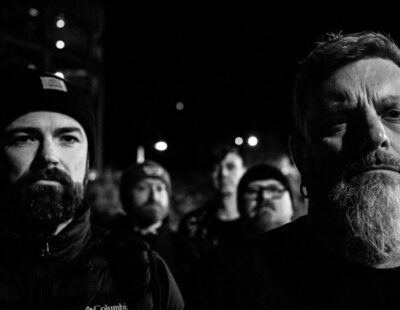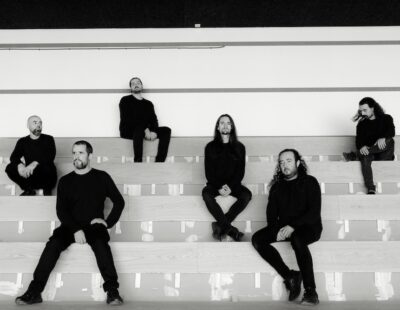
Canadian folk-black metal outfit Thrawsunblat blaze a rough trail on their new album Great Brunswick Forest. It maintains all the rugged melodies of their previous records, but does so for the most part without any electric guitars.
Can you even do metal without electric guitars? One memorable (and unfunny) episode of Metalocalypse asked this same question. For the most part, I think the common consensus is that you cannot — but Thrawsunblat have proven that notion wrong. The Great Brunswick Forest rumbles and pounds. On songs like “Here I am a Forretress” the rugged sense of being a singular actor amid the wilderness —the proverbial wanderer above a sea of fog — is presented without black metal buzzing. It works.
To be sure, there’s some history of metal rocking out without humbuckers and tube amps. Sandy Denny sang on Led Zeppelin’s “The Battle of Evermore”, but was otherwise best known for her singular work in Fairport Convention (please, bump their version of “Matty Groves”). Later, Ulver charted similar territory. In 2018, though, this was a bold move.
We spoke with Thrawsunblat mastermind Joel Violette about what exactly possessed him to take this unique direction on Great Brunswick Forest.
The biggest change for Thrawsunblat fans on this album is going to be the instrumentation – much of the record is acoustic. Obviously folk music has always been a big part of the Thrawsunblat formula, but this time around things have a very, very acoustic sound – what precipitated that creative decision?
I had a lot of acoustic-based songs in the forge and then one day suddenly noticed this fact. I decided it was high time to group them and try to classify them in some meaningful way and hopefully bring them to life. So I asked, what do these all have in common? Is there a commonality between all of them? The answer was of course yes, and thus was born the idea of the Great Brunswick Forest. The album being a Thrawsunblat album it also needed to have certain energy to it. At this point some decisions had to be made about how we might put this Thrawsunblat energy into an acoustic album, and thus was born songs like “Fortress and Wind”. And thus the thing was able to come to life and tick all of the checkboxes a Thrawsunblat album must.
While I say that the record is very acoustic, one interesting thing is that, to my ears, it’s definitely still a metal album. Someone reading this and not hearing the record might think it sounds like Fotheringay, or the lighter Led Zeppelin tracks but it does not. The guitars are thick and present, the drums are energetic and pounding, when called for. Was this the effect you wanted? And how did you achieve it?
I’m glad you think so! That is the exact effect I was hoping for. Metal, but with a woodier and warmer sound. I wanted the album to be heavy, to have that Thrawsunblat energy, yet for its colour to be taken from its acoustic instrumentation. I think that the foresty, folky sound is more directly tailored to the purely acoustic instrumentation. There is a certain sound and headspace that it provides which is simply impossible with heavy guitars. For Thrawsunblat especially this is a brand new sound but generally not a sound I’ve heard much elsewhere either, so exploring it on the scale of a full album was something I was excited to do.
What was the greatest challenge you faced in putting this record together?
This was undoubtedly moving the vocals to the front. It was a step forward for me as a vocalist, and took quite a lot of work. With harsh vocals you can hide behind guitar melodies: if the vocals are not interesting, that’s fine because a person can listen to the guitars instead. With the vocals out front carrying much of the energy — as they are this album — there is nowhere to hide. On heavy albums the drums and guitars carry a lot of the weight. Here the vocals are just as important as the guitars and drums in terms of providing energy, so it was a real challenge to accomplish that.
Are there any songs on IV that feel particularly meaningful to you, or that you are particularly proud of?
That’s a tough question because innately every song I feel worthy of an album is meaningful. The song I am most proud of is “Here I Am a Fortress”, as it has an energy and song structure reminiscent of black and melodic death, but done in a folky acoustic medium — while sounding like none of the three genres. “Green Man of East Canada” is another favourite, as it encompasses this idea of folkiness itself. I’m also quite attached to “Singer of Ageless Times” as its fiddle riff is one of my favourite of all the melodies I’ve ever written, and it also has a very historic Fredericton feel to it.
The lyrics on IV specifically deal with the folklore and history of eastern Canada. As an American, I don’t really have any good conception of what it means to be an Atlantic Canadian, or what tales compose the folkloric culture there. Usually metal songs set in Atlantic Canada are about the Vinlanders, and so are really ‘Scandinavian’ tales. Can you offer me any insight into the folkloric tradition of the region that you drew from on the record for your lyrics?
I find the Vinland monopoly especially fascinating. Metal seems to keep more with mythology than with folklore, so when you have an ancient tale like the Vinland saga connecting to an ancient mythology, this is fertile ground. The story is also pretty remarkable in itself — exploring the vast unknown and transnavigating the Atlantic. Quite metal.
But to answer your question — simply put, I didn’t! I drew not from specific folklore, but rather from universal folkloric elements, like the idea of the Green Man, which I think well reflect the traits and characteristics of the place. After that, much of the material deals with history in terms of those who came before us both physically and culturally. Where do we get our influences? Where did our influences get their influences? Will people in the future be influenced in some small way by things we create now? And I explored all of that within the context of Atlantic Canadian landscape.
Were there any records that you can cite as particular influences on this album, and the acoustic rock sound you were going for on it?
It’s the following set of questions that are behind the sound: What happens when you try to be heavy and complex with acoustic guitars? Can you provide an immersive atmosphere that transports the listener? Tull’s Songs from the Wood, Fairport Convention’s Liege & Lief, and Steeleye Span’s Below the Salt proved quite firmly that it could be done, and so here we are trying our own hand at it in 2018 Canada. Another question that informs the sound, and provides perhaps the 2018 spin is: “What happens if you play Amon Amarth’s Versus the World on acoustic guitars?”






